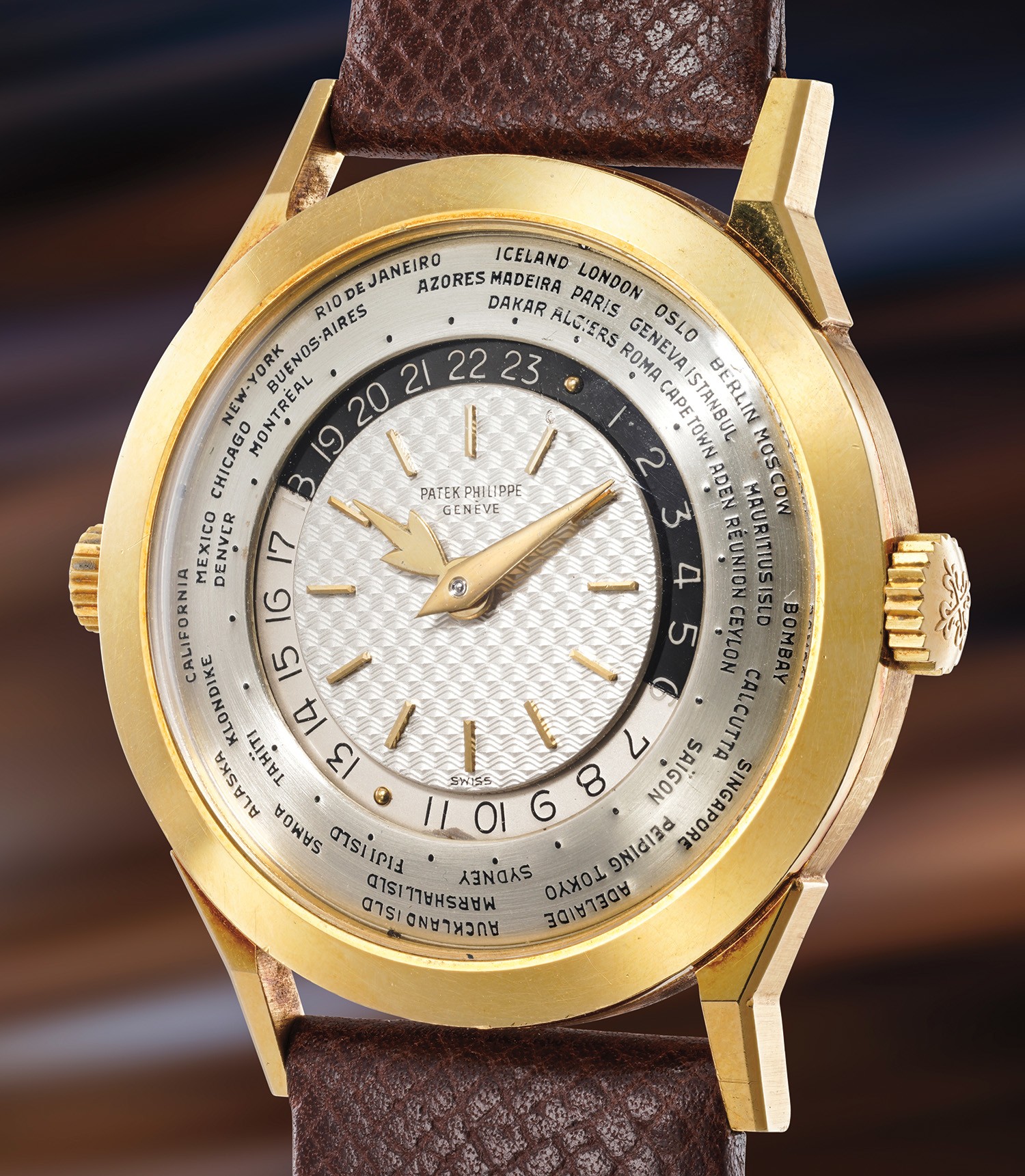
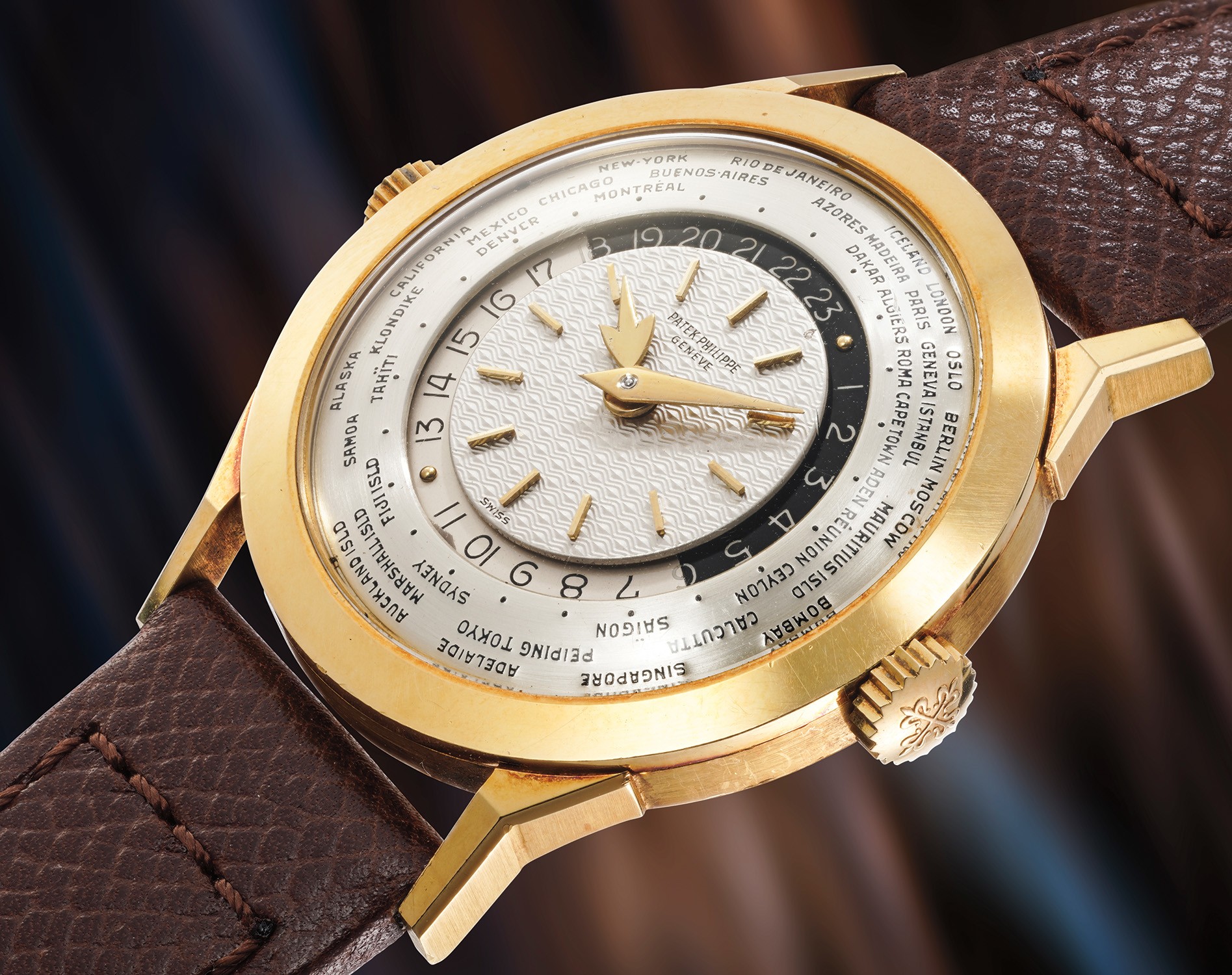
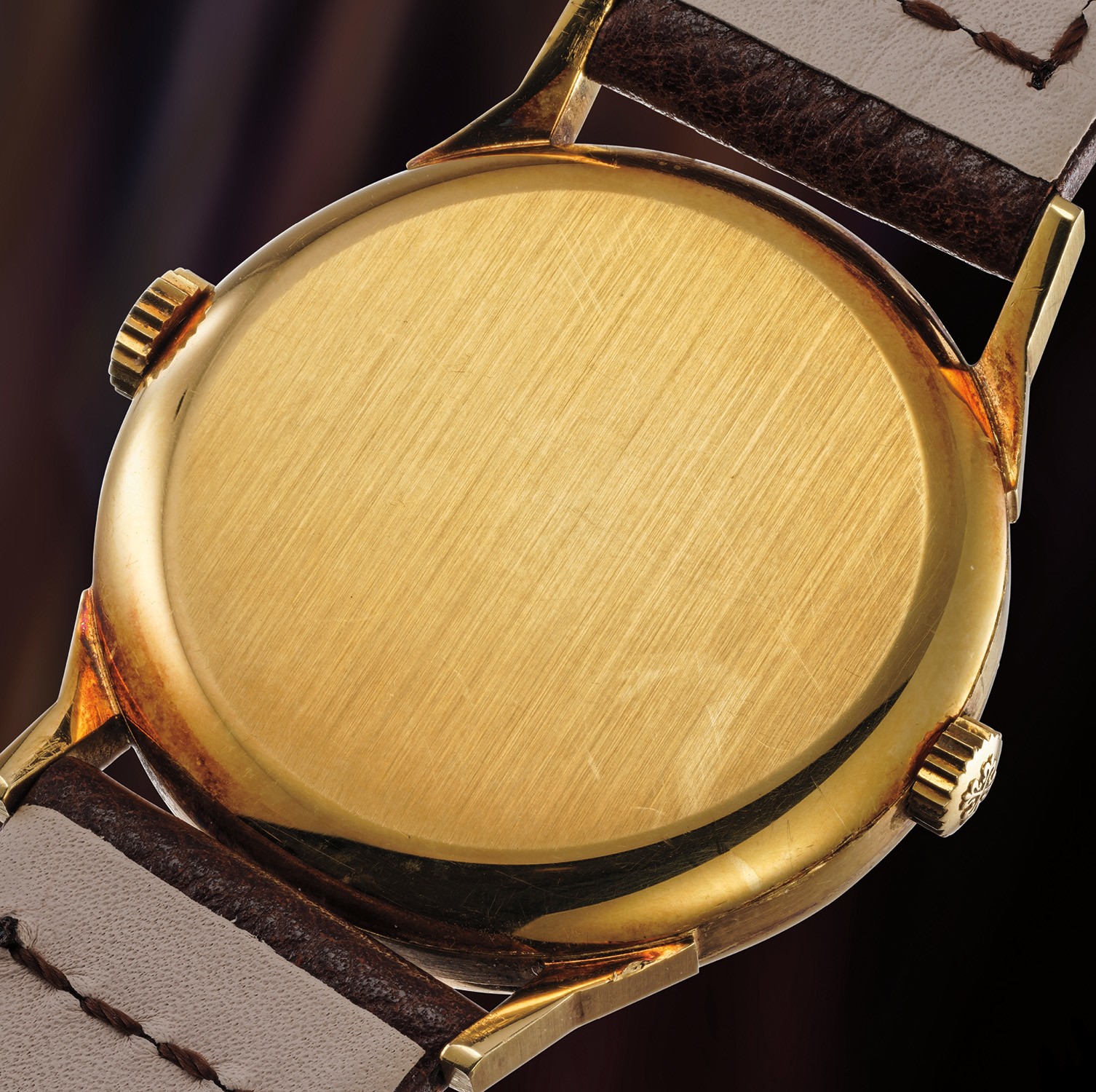
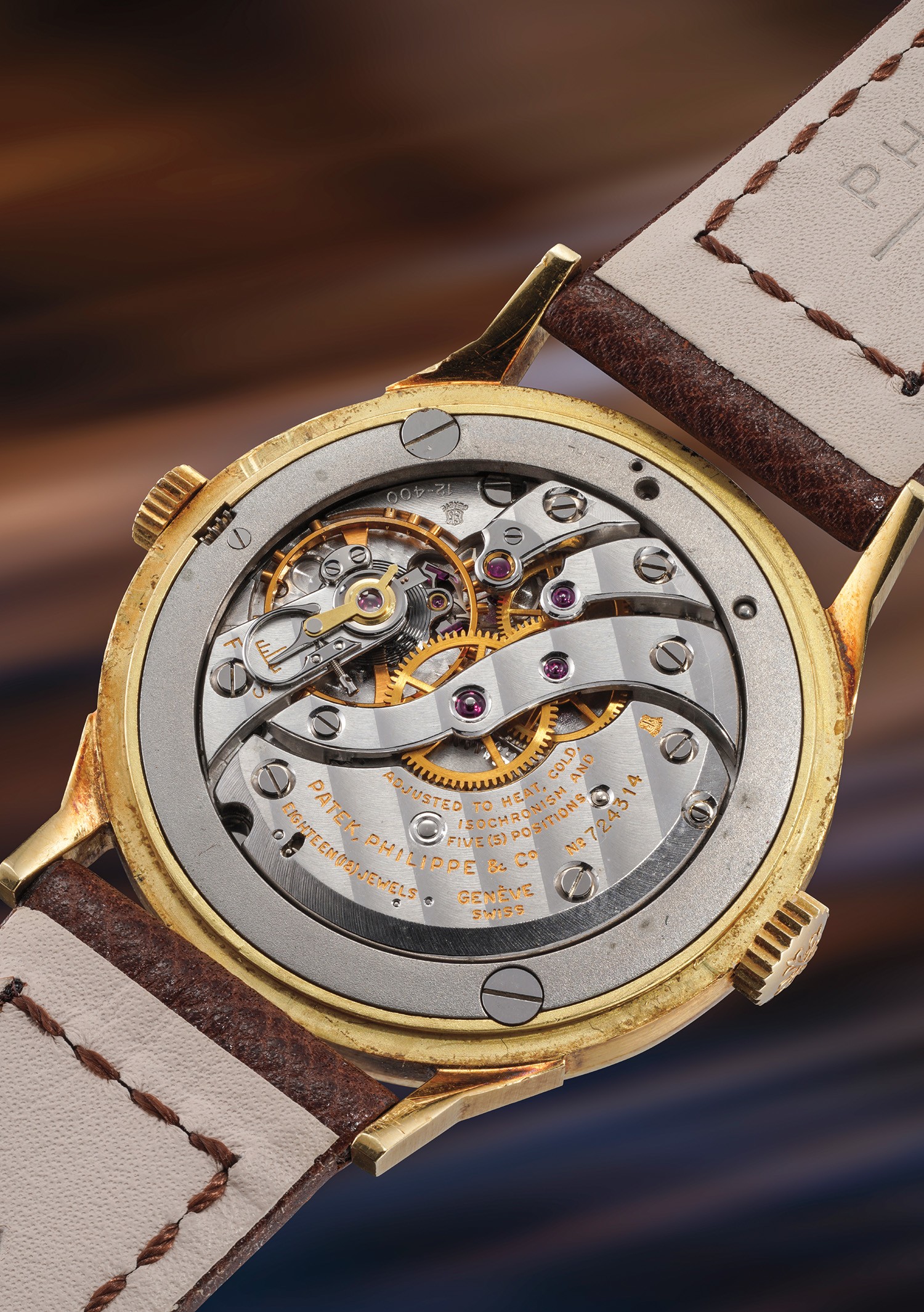
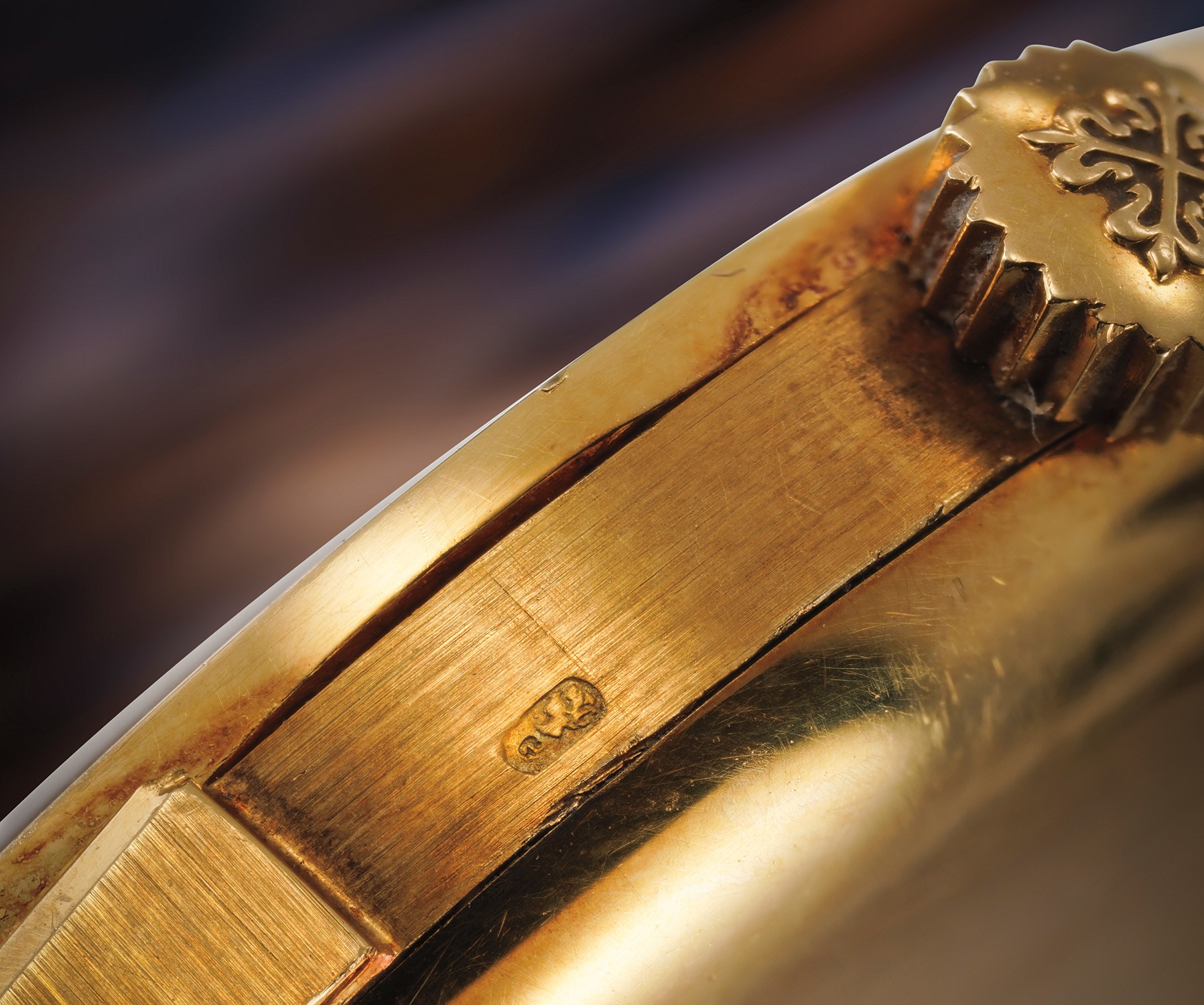
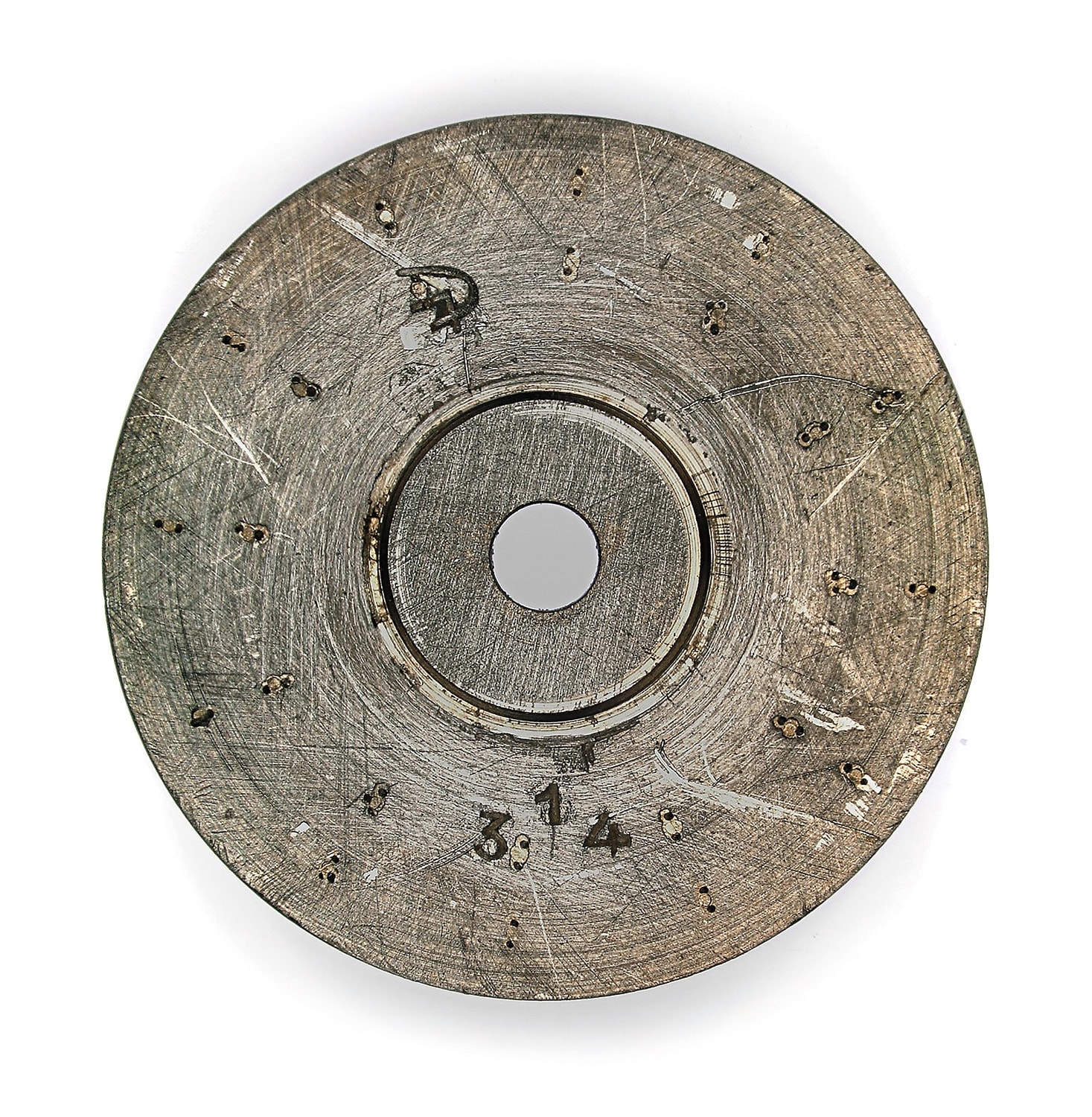
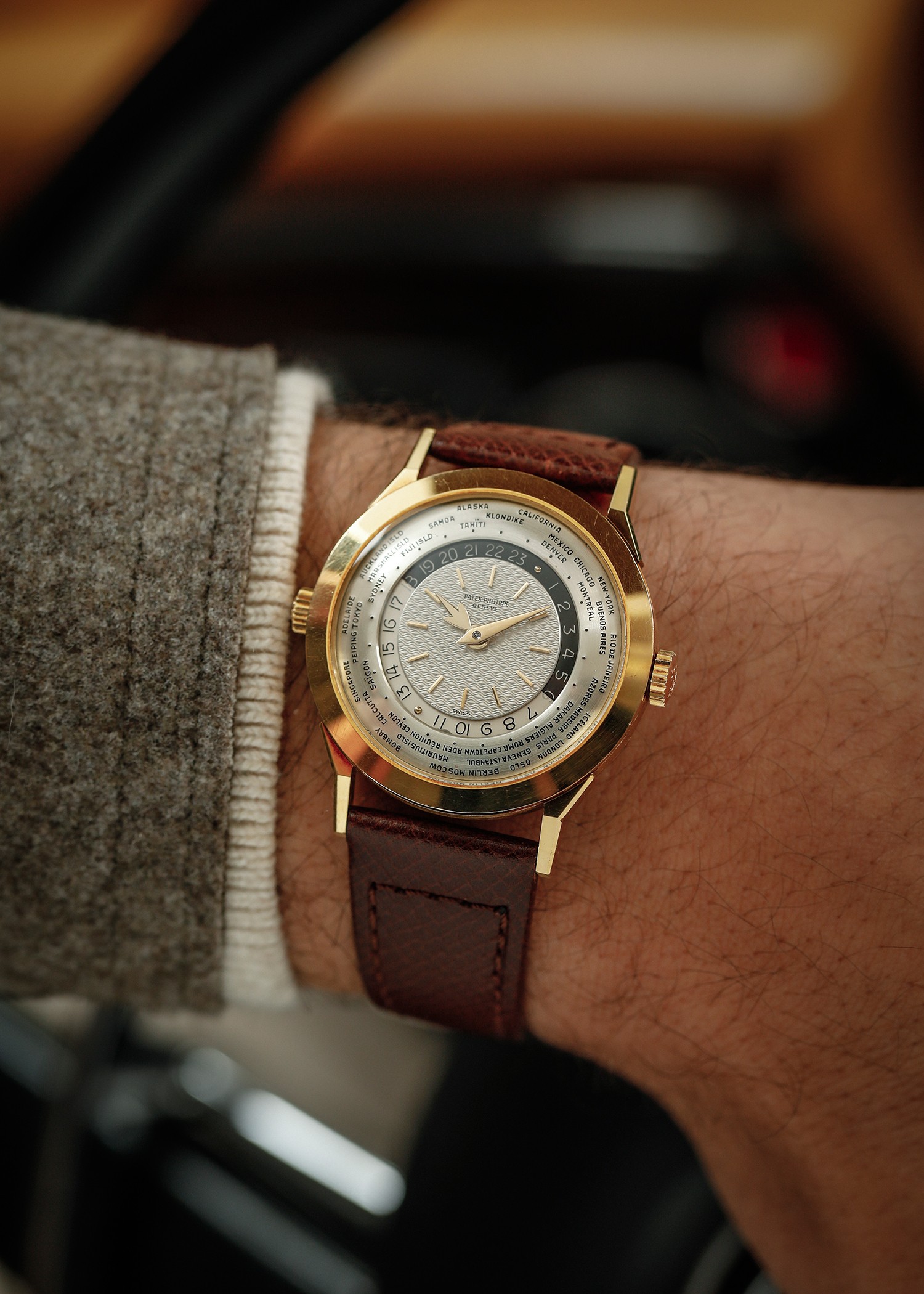
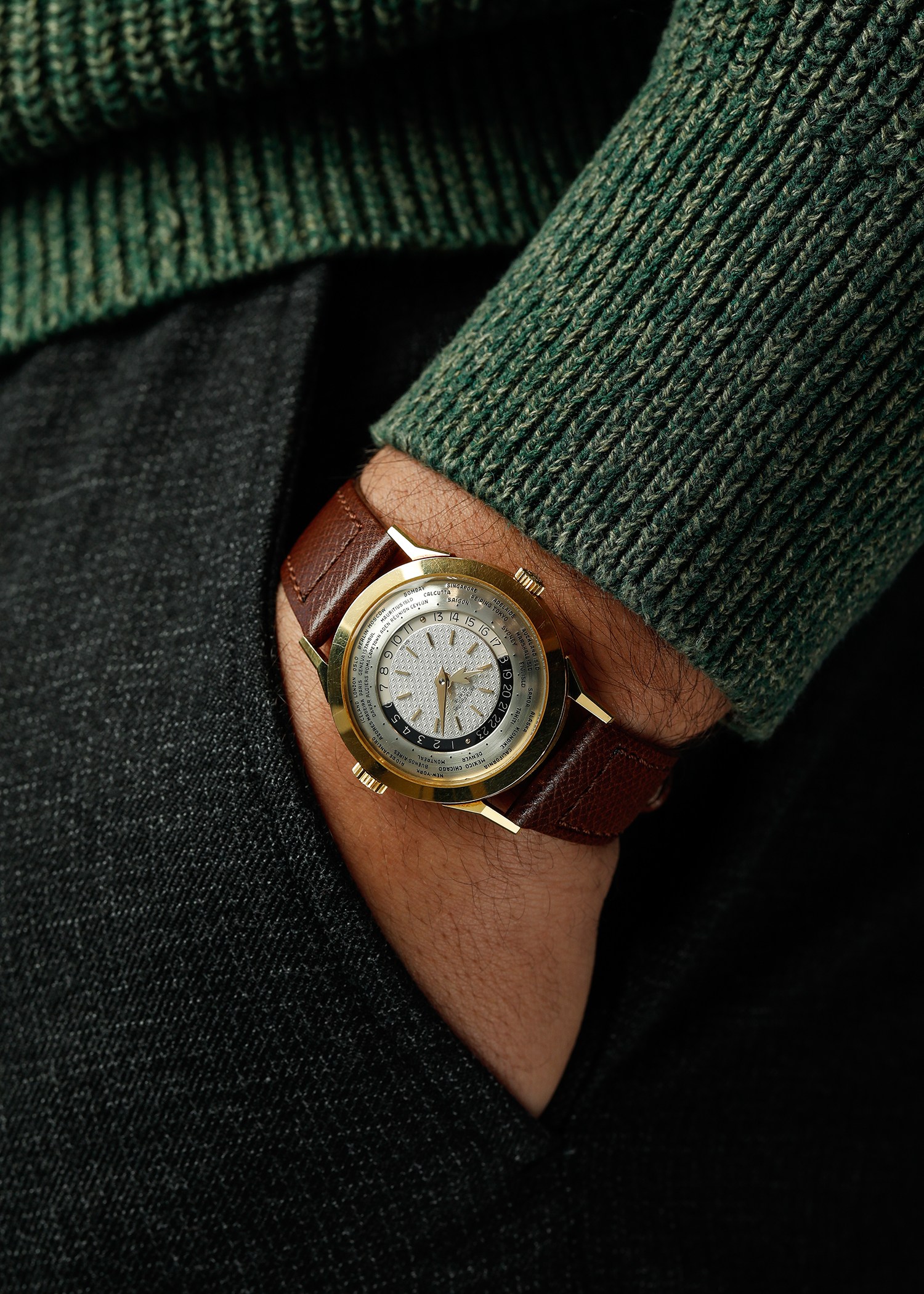








55
Patek Philippe
Ref. 2523/1
Two-Crown World Time, Ore del Mondo Doppia Corona
An astoundingly well-preserved, highly important and supremely scarce yellow gold world time wristwatch with two crowns, guilloché dial and metallic city ring
Full-Cataloguing
The present example is without a doubt one of the most appealing and collectible Patek Philippe two-crown worldtime wristwatches to ever come to market in virtue of its unpolished case which perfectly preserves all the details of its peculiar architecture in absolutely unmolested condition. All the facets of the lugs are perfectly preserved, with sharp edges. The inward step where the lug joins the band is incredibly prominent, the satin finish is original and unspoiled and the hallmark is a joy to behold.
The dial is as impressive as the case, featuring a city ring with strong engraved/enamelled graphics in beautiful contrast with the metallic finish. The guilloché center is absolutely pristine, without hints of oxidation. The 24-hour ring features perfectly preserved graphics, without signs of fading.
Such remarkable condition is not only a rarity but also a necessity if one is to admire this design in all of its unabashed beauty, especially concerning the case: even the most minute rounding of the edges dramatically alters its aesthetic effect which so strongly relies on facets and edges to convey its power.
THE WORLD TIME SYSTEM
The complication is defined by the presence of two rings: a fixed - but adjustable - one with the 24 time zones, and a second 24-hour ring, usually divided in nocturnal and diurnal halves for easier readability, revolving counterclockwise. This simple but brilliant system allows for the correct time for each city to be read on the respective adjacent segment of the 24-hour ring: a true Columbus’ Egg of watchmaking.
The worldtime complication is a direct consequence of the advancements in the field of communication technology. While today it is rightfully identified as a traveler’s complication, its original purpose was in fact more “static”; the earliest examples do not even have a system to adjust the time zone. In its first conceptualisation, it meant to allow people with international business/interests to track simultaneously the time everywhere in the world. Imagine being PanAm CEO in the 1950s, and having to place consecutive calls (a real-world situation, since the mid first half of the past century) to your Tokyo, Rome, New York and Sydney offices. Knowing what time it is in each city helps you plan the calls. That is why watchmaker Louis Cottier developed the system in the 1930s, when intercontinental telecommunication was beginning to be more commonplace. Very early in it’s evolution, however, the revolving city ring was introduced, thus “consecrating” forever the worldtime as a traveler’s timepiece.
Reference 2523 is in fact the final step (in vintage wristwatches) of a refinement process that had begun two decades earlier. The very first Patek Philippe examples of the system involved a fixed city ring (as mentioned, without the possibility of easily changing the local time zone) and were executed as practically one-off -pieces such as reference 515 (a rectangular model), two modified examples of reference 96 (96HU), and references 542 and 1416, two 3-piece series, probably market tests - together with a prototype series of three 1415 examples.
The first serially produced model was reference 1415, featuring a 31mm diameter and a rotating 24h ring and fixed city bezel, allowing for user-friendly change of time zone. In fact it proved itself quite successful - for such a new and unorthodox model - with about 115 pieces made mostly during the 1940s.
The evolution of ref. 1415, reference 2523 is miles away from its ancestor in terms of design. It features an oversize-for-the-time 36 mm case, two crowns (one to set the city ring) and a city ring which becomes integral part of the dial rather than being engraved to the bezel (a “bead and notches” system allows for the city ring to smoothly snap into place at each time zone, a detail which highlights the attention Patek Philippe reserved to this model).
It would seem that such elaborate and refined aesthetics - which make the timepiece so iconic and attractive nowadays - were too ahead of their time: reference 2523 was in fact a commercial disaster, and consequently production was very limited. A slightly modified version (ref. 2523-1, the present watch) was launched as well, but with no different outcome.
The importance of this model is well recognised by the brand itself: 3 examples are housed in the Patek Philippe museum.
LOUIS COTTIER
Born in Geneva in 1894 to automata-maker Emmanuel Cottier, Louis Cottier was consequently in contact with watch/automata-making since the very beginning of his life. He was formally trained in watchmaking at the École d’Horlogerie in Rue Necker, Genève. During these years, he was classmate with Edouard Wenger - celebrated casemaker and lifelong friend.
After school, he worked for Jaeger until 1931, when the Great Depression had him lose his job and subsequently set up his own shop in Geneva at 45, Rue Vautier. It is with the introduction of the worldtime system that same year (patent no. 270085) that he made his name immortal. In fact, the inspiration for the idea came from his father’s unsuccessful attempt at tackling the same problem. When introduced, the worldtime complication was truly novel, with a completely new aesthetic layout and addressing a previously non-existent need. The novelty effect was in fact a success, and companies such as Vacheron Constantin, Agassiz (today known as Longines), and Rolex were also among Cottier's clients.
In 1947, he moved to 20, Rue Ancienne and began to industrialise and improve his production methodology. It is during these years that he acquired the trust of Rolex’s founder Hans Wilsdorf to the point that, also thanks to the recommendation of horological historian Alfred Chapuis, he was appointed curator of his collection, a post most congenial to him also due to his love for history. He was in fact also a dedicated scholar of Genevan History, and his renown in the field was so high that important collectors would go to him asking not only for restorations, but also for historical researches on their timepieces. Furthermore, he was also a talented painter and aquarellist.
Later in his career, he kept developing new horological solutions, mostly for Patek Philippe, such as the present two-crown update to his worldtime system (1950); a 1954 wristwatch with double dial but single movement (a world’s first) and 1958 linear hour watch (which is the inspiration for the contemporary Urwerk’s “Cobra” timepieces).
His final contribution to watchmaking history comes in 1959, when he patented the jump-hour travel time system found on Patek Philippe reference 2597.
He passed away on September 16, 1966 in Carouge, the Geneva neighborhood where he lived and worked for virtually his entire life.
TECHNICAL ANALYSIS
Case: Made by Geneva-based Antoine Gerlach - poinçon number 4 in a Key - it is one of the most fascinating and complex Patek Philippe designs. Already, the inclusion of a second crown - making this the only vintage single-dial Patek Philippe model sporting 2 crowns - was extremely avant-garde. The large 36mm diameter was also destined to raise eyebrows, especially when found in an elegant gold Patek Philippe dress watch. However, it is the design of the lugs that will live on as one of the most brave - and ultimately impressive, even though it took decades to be appreciated - architectures employed by the brand. These cases in fact present a distinct evolution:
- The design of ref 2523 is consistent throughout production, with faceted lugs raised above the bezel. The case numbers are randomly found within the 306’1xx/306’2xx range, with one outlier (305’699).
- The cases of ref. 2523/1 feature instead consecutive numbers and present an evolution
- Earlier watches (First Series - lowest case no. known: 313’036; Highest: 313’043 ) feature a more streamlined, facet-less lug design. The lugs are not raised above the bezel.
- Later pieces (Second Series - lowest known case: 724’044; highest: 724’051) reintroduce the faceted design of ref. 2523 but keep a lower height, with the lugs not going above the bezel. Practically, this last evolution strikes the sweet spot between the previous two iterations.
A downside of the faceted lugs design is that the soft gold edges are very sensitive to polishing, with many examples of the model featuring rounded edges. Luckily, the present instance happens to be one of the very few case which survived absolutely unpolished until today, allowing us to admire this architecture in all of its glory.
Dial: Two-crown worldtime Patek Philippe watches feature a number of different dials. Possibly due to the original lukewarm reception, Patek Philippe spared no artistic effort on the model: it is known with plain silvered dial (2523-1 First Series), blue enamel dial (found on 2523), cloisonné enamel dials (2523) and engine-turned dial (found both on 2523 and on Second Series 2523-1 such as the present piece, albeit different designs).
Such variety is remarkable - especially for a model made in few dozens pieces - and indeed was maybe an effort to lure in clients with different tastes.
This example - as all the 4 yellow gold second series known - feature a silvered guilloché center decorated in a very unusual waves/lozenges pattern
The city ring as well features an evolution, with earlier version (2523 and 2325/1 First Series) featuring a matte grené finish while the Second Series of ref. 2523/1 - the present watch - features a metallic-finish dial very much in tone with the guilloché center for a somewhat futuristic/steampunk effect.
A recap of the dial evolution for the model looks as follows:
Ref. 2523 can feature (without real chronological order) the following dials (and the city ring is always matte): - golden guilloché dial - blue enamel dial - cloisonné dials
Ref. 2523-1 can feature:
- First Series: plain silvered dial, matte city ring - earliest known: 724’302, latest known: 724’309.
- Second Series: silvered guilloché dial, metallic city ring - earliest known: 724’310, latest known: 724’310.
Movement: The overall execution of the timepiece is, from a purely technical standpoint, absolutely extraordinary. The watch is powered by one of Patek Philippe’s most reliable “time only” movements of the time, 12 lignes calibre 12’’’400, personally modified by Louis Cottier - the inventor of the world time system. Going beyond the usual Patek Philippe quality, the restricted production output and the differently decorated dials meant that each one of these watches was treated practically as a Pièce Unique - the most important components of the movement and dial hand-finished and univocally linked to each watch: in fact, a movement number can be found on virtually all the main parts, including the 24 hour disc (last three digits stamped to the back), the city ring bracing (last three digits hand-engraved to the front), obviously on the movement (both sides), and also to the underside of the guilloché disc together with Louis Cottier’s monogram LC. This last detail is not only an intellectual “Easter Egg”, but it underscores the fact that the legendary watchmaker insisted for personally executing the final assembly of every single one of these specimens (and to hand-make the hands).
PRODUCTION DETAILS AND NUMBERS
A comprehensive list of all the known 2523/2523-1 is summarised in the table below which shows us that: the production of reference 2523 movements was made in two batches, one starting with movement no. 720’300, and the other with no. 722’700. Yellow, pink and white gold examples are known.
The latest known movement no. of the first batch is 720’308, and movement 720’312 is a ref. 96, thus the total output of this batch is between 9 and 12 pieces.
The latest known movement no. of the second batch is 722’719, and movement 722’724 is a ref. 2431, thus the total output of this batch is between 20 and 24 pieces.
Consequently, the total output for reference 2523 must be between 29 and 36 pieces.
The production of reference 2523-1 is even more restricted, most likely around 20 pieces in total with consecutive movement numbers and a production evenly split between First and Second Series
First Series (flat lugs, plain silvered dial, matte city ring): most likely starting with 724’300 (but the earliest known is 724’302) up to 724’309 - potentially 10 pieces, 5 are known all in yellow gold.
Second Series (faceted lugs, guilloché dial, metallic city ring - the present watch): they start at 724’310 and the last known example is 724’318 - most likely it was made in around the same numbers as the First Series but no movement number has appeared on the market from 724’319 to 724’334 (a ref. 2500R). 8 Second Series pieces are known, 4 in yellow gold and 4 in pink gold.
Below, a list of all known watches:
2523 FIRST BATCH
720’300 - 305’699 - YG - Guilloché
720’301 - 306’193 - YG - Eurasia
720’302 - unknown
720’303 - 306’197 - YG - Eurasia
720’304 - 306’201 - YG - Eurasia
720’305 - unknown
720’306 - unknown
720’307 - unknown
720’308 - 306’199 - YG - Gold Guilloché
720’309 - unknown
720’310 - unknown
720’311 - unknown
720’312 - ref. 96
2523 SECOND BATCH
722’700 - 306’202 - YG - Guilloché
722’701 - unconfirmed - YG - Guilloché
722’702 - 306’207 - YG - Guilloché
722’703 - 306’208 - YG - Blue enamel
722’704 - 306’209 - YG - Blue enamel
722’705 - 306’204 - YG - Blue enamel
722’706 - 306’205 - YG - North America
722’707 - 307’475 - WG - North America
722’708 - 306’210 - YG - North America
722’709 - 306’211 - YG - North America
722’710 - 306’206 - YG - South America
722’711 - 306’212 - YG - South America
722’712 - 306’213 - PG - Guilloché
722’713 - unknown
722’714 - 306’215 - PG - Blue enamel
722’715 - 306’216 - PG - Blue enamel
722’716 - 306’217 - PG - North America
722’717 - 306’218 - PG - North America
722’718 - unknown
722’719 - 306’220 - PG - South America
2523-1 First Series
724’300 - unknown
724’301 - unknown
724’302 - YG - silvered
724’303 - YG - silvered
724’304 - YG - silvered
724’305 - unknown
724’306 - unknown
724’307 - YG - silvered
724’308 - Unknown
724’309 - YG - silvered
2523-1 Second Series
724’310 - YG - guilloché
724’311 - YG - guilloché
724’312 - YG - guilloché
724’313 - unknown
724’314 - YG - guilloché
724’315 - PG - guilloché
724’316 - PG - guilloché
724’317 - PG - guilloché
724’318 - PG - guilloché
Combining rarity, technical proficiency, mind-blowing good looks and ultimate exclusivity, this watch is unarguably one of the most important timepieces in existence and it would be the crown jewel of even the most important wristwatch collection.
Patek Philippe
Swiss | 1839Since its founding in 1839, this famous Geneva-based firm has been surprising its clientele with superbly crafted timepieces fitted with watchmaking's most prestigious complications. Traditional and conservative designs are found across Patek Philippe's watches made throughout their history — the utmost in understated elegance.
Well-known for the Graves Supercomplication — a highly complicated pocket watch that was the world’s most complicated watch for 50 years — this family-owned brand has earned a reputation of excellence around the world. Patek's complicated vintage watches hold the highest number of world records for results achieved at auction compared with any other brand. For collectors, key models include the reference 1518, the world's first serially produced perpetual calendar chronograph, and its successor, the reference 2499. Other famous models include perpetual calendars such as the ref. 1526, ref. 3448 and 3450, chronographs such as the reference 130, 530 and 1463, as well as reference 1436 and 1563 split seconds chronographs. Patek is also well-known for their classically styled, time-only "Calatrava" dress watches, and the "Nautilus," an iconic luxury sports watch first introduced in 1976 as the reference 3700 that is still in production today.